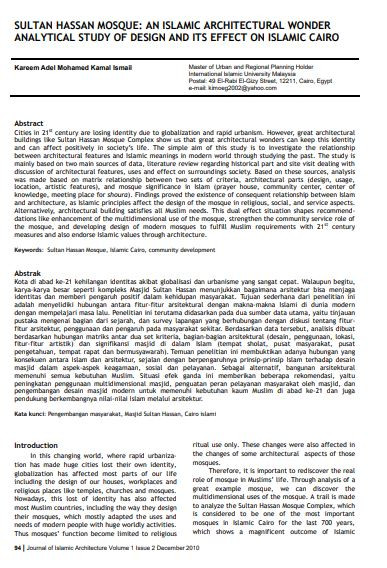
Cities in 21st century are losing identity due to globalization and rapid urbanism. However, great architectural
buildings like Sultan Hassan Mosque Complex show us that great architectural wonders can keep this identity
and can affect positively in society’s life. The simple aim of this study is to investigate the relationship
between architectural features and Islamic meanings in modern world through studying the past. The study is
mainly based on two main sources of data, literature review regarding historical part and site visit dealing with
discussion of architectural features, uses and effect on surroundings society. Based on these sources, analysis
was made based on matrix relationship between two sets of criteria, architectural parts (design, usage,
location, artistic features), and mosque significance in Islam (prayer house, community center, center of
knowledge, meeting place for shoura). Findings proved the existence of consequent relationship between Islam
and architecture, as Islamic principles affect the design of the mosque in religious, social, and service aspects.
Alternatively, architectural building satisfies all Muslim needs. This dual effect situation shapes recommenddations like enhancement of the multidimensional use of the mosque, strengthen the community service role of
the mosque, and developing design of modern mosques to fulfill Muslim requirements with 21st century
measures and also endorse Islamic values through architecture.
I agree to the terms outlined below:
You agree to upload and assign Mosqpedia Database the rights to use the content worldwide and in perpetuity across all current and future media platforms. Mosqpedia Database may edit, copy, adapt and translate your contribution.
The content will be distributed under the Creative Commons Attribution-Deed – Attribution-NonCommercial-NoDerivatives 4.0 International – Creative Commons
All data will be stored in line with data protection regulations.